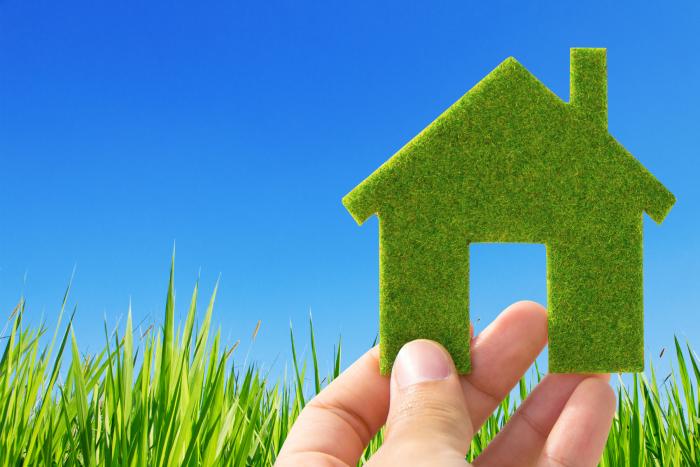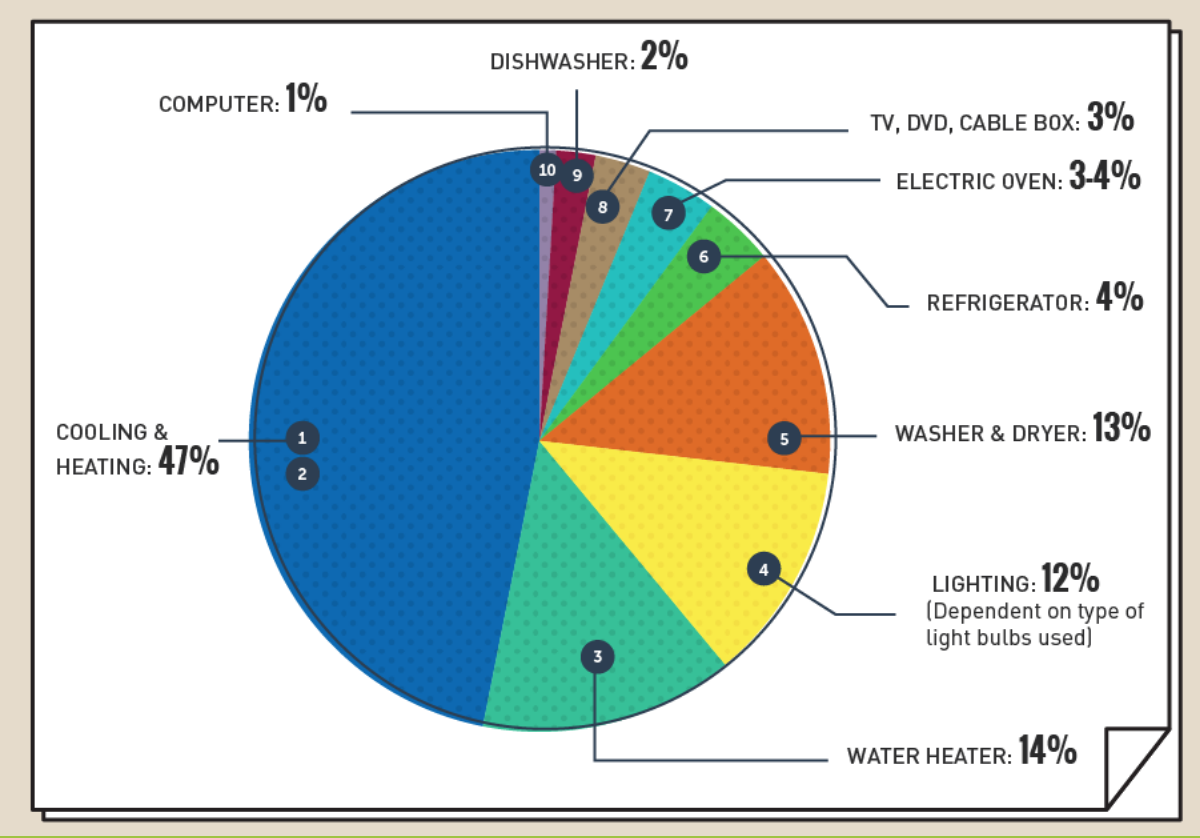Boosting Your Home's Energy Efficiency - A Starter Guide


So you’re considering steps to make your home more energy efficient but don’t know where to start. Well, you’re on the right track - energy efficient means using less energy and therefore paying for less energy. Despite an initial investment, this will make your home less expensive to maintain in terms of utility bills. Naturally, in the long run, there are environmental benefits you can’t put a price on - improving the health of the planet thanks to decreased carbon emissions.
Take a look at the chart below for an idea of where most of your energy currently goes. According to this, the biggest slice of the pie is heating and cooling at 47 percent or almost half of total energy use, followed by your water heater at 14 percent and washer/dryer at 13 percent and lighting at 12 percent. It goes without saying that making a difference in these top categories will make the most impact on your drive towards energy efficiency.
Top Ten Energy Users in the Average Home:

The Biggest Sources of Residential Energy Consumption - an infographic by Uma Campbell
Understand your baseline:
It’s important to know what you’re working with, so begin by checking your electricity and heat bills. Chances are that cooling and heating are significant contributors for you as well. Consider any particular issues you’re trying to address. Are your heat bills absurdly high but you never feel warm? Make a note of what costs the most and least, then follow up with a home energy audit.
Hiring a professional for an energy audit is helpful, especially since they are often subsidized by the state or utility companies and in some cases may even be free. However, you can conduct your own energy assessment as well. Check out this site by the U.S. Department of Energy for some pointers. An energy audit means a thorough assessment of how energy is used in your home and how it can be saved. This will involve external and internal measurements, review of daily activities and utility bills, number of people live in the house, if anyone is home during the day, average thermostat temperature during the various seasons, and more. This data is essential to break down the costs of your energy bill and identify areas to address by telling you what products are old, inefficient and using too much power.
Completing the energy audit is just the first step in saving money on energy bills - it will identify issues within the home and dealing with those issues will help reduce waste of energy and reduce costs.
You should also calculate your household’s carbon footprint. This information is crucial to establishing your high level goals and exploring how different approaches can affect energy savings.
Get professional advice:
Green consultants can confirm your initial energy assessment (if you did it yourself) and help plan how your property can be more energy and resource efficient. They will propose options, prioritize them, and provide cost estimates to make your good efficiency intentions real. They can assist with visualization and suggestions for the bigger picture as well as the implementation of the details, all while keeping an eye on the price.
What possible solutions may look like:
It is natural to feel somewhat overwhelmed with the choices and expenses but it is worthwhile to remember that every little bit helps. For example, residential energy consumption is the third largest use of energy in the US - of that only 65% is actually used and 35% is wasted. That means every home is wasting a significant portion of its energy but it doesn’t have to be that way. Even minor fixes can add up to major savings and the short and medium term solutions can be considered do-it-yourself projects.
-
Here are some examples of low cost and short term steps that can be completed in the course of an afternoon, with the materials available no further than your local hardware store.
-
Start by using more Light Emitting Diodes or LEDs, which produce light approximately 90% more efficiently than incandescent bulbs
-
Caulking and weatherstripping around leaky doors and windows to prevent drafts from entering and heated air from leaving the house
-
If your boiler and water heater are hot to the touch, wrapping pipes and the hot water tank will also create energy savings
-
-
These medium term, reasonably priced changes will probably take a weekend at most of your time and prevent significant energy loss.
-
Easy to install exterior storm windows and doors are one of the most cost-effective solutions for upgrading energy inefficient existing windows and cost a fraction of replacement windows
-
Installing insulation and sealing floors between a cold, drafty garage and the living spaces above can save energy and money
-
A poorly insulated and leaky attic access is almost the same as an opening to the outdoors - you can build your own insulated cover box or purchase a kit or a pre-built box
-
-
Lastly, there are long term additions on a substantial scale that need to be professionally undertaken.
-
Windows, doors and skylights protect you from the elements just like a winter coat and just like a winter coat, they need replacement when they wear out
-
Water heaters are the second highest source of energy usage in the home, accounting for about 14-18% of your energy use - reducing your hot water use and choosing an energy efficient water heater can reduce your monthly water heating bills
-
Older furnace and boiler systems had efficiencies in the range of 56% to 70%, but modern heating systems can achieve efficiencies as high as 98.5%, converting nearly all the fuel to heat with minimal waste
-
Homes and businesses are transitioning away from a fossil-fueled electricity grid towards clean energy - optional projects like installation of solar panels can be a source of considerable savings
-
For climates with both heating and cooling needs, heat pump systems offer an energy-efficient alternative to furnaces and air conditioners. Like a refrigerator, heat pumps use electricity to move heat from a cool space to a warm space, making the cool space cooler and the warm space warmer.
-
The larger the physical footprint of your home, the larger the environmental footprint as well, in terms of material and energy use. Three decades ago, the average size of the American home was about 1000 square feet while the average size today is about 2,400 square feet. With more energy being used, the more potential there is for waste, which is why it is imperative that we consider our options responsibly.
Be assured, that whatever the size of your home, there are ways to both save energy and stay comfortable. Improving your home’s energy efficiency is not always about building a whole new green home or even undertaking a renovation by tearing down walls. It is about sensible steps which take you in the direction of sustainability as well as taking the stress off your pocketbook and the planet.
- Filed Under: Energy
- Keywords : Energy, Energy Audits, Energy Star, Energy Efficiency, HVAC
- ( 14209 ) views

Master's in Media Innovation from Northeastern University Freelance journalist and blogger
- ( 0 ) Ratings
- ( 0 ) Discussions
- ( 0 ) Group Posts
Reply/Leave a Comment (You must be logged in to leave a comment)
Connect with us!
Subscribe to our monthly newsletter:
 Greenbuild Report Out, 2025 Nov 12, 2025
Greenbuild Report Out, 2025 Nov 12, 2025






























Not a Member Yet? Register and Join the Community | Log in